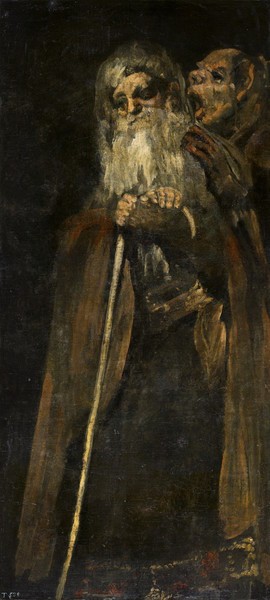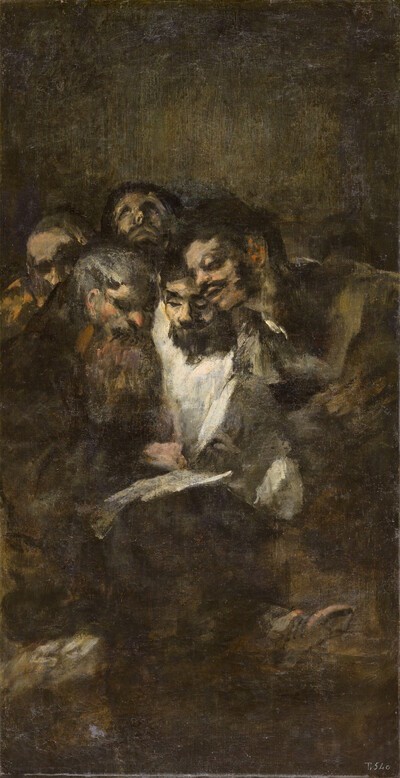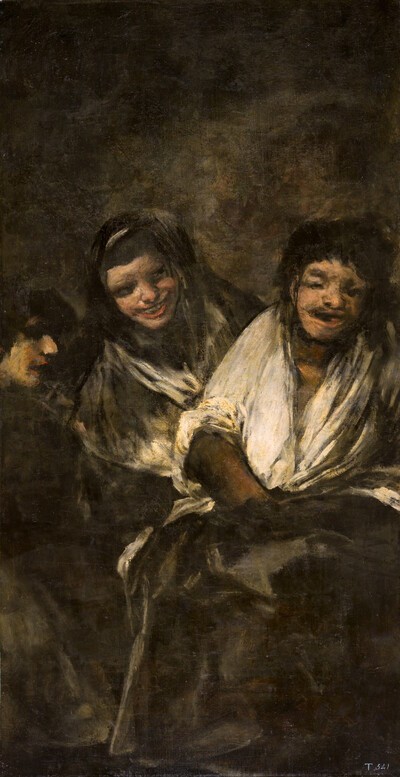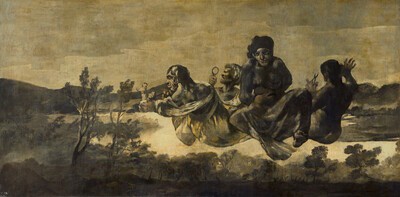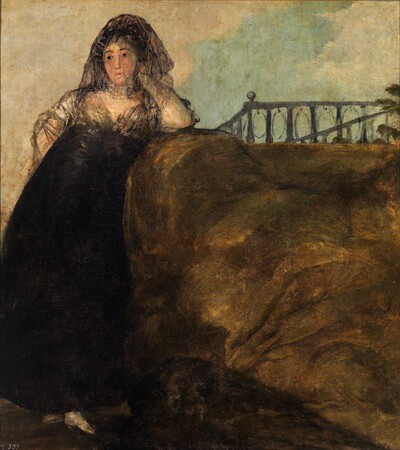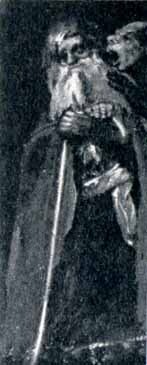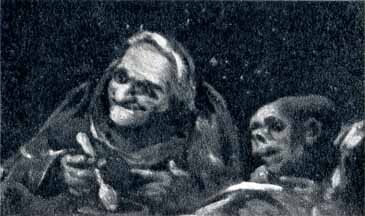- Cronología
- Ca. 1820 - 1823
- Ubicación
- The Prado National Museum. Madrid, Madrid, Spain
- Dimensiones
- 142.5 x 66 cm
- Técnica y soporte
- Oil painting on plaster transferred to canvas
- Reconocimiento de la autoría de Goya
- Undisputed work
- Titular
- El Prado National Museum
- Ficha: realización/revisión
- 26 Oct 2010 / 13 Jun 2023
- Inventario
- (P00759)
- Otros títulos:
-
Two Monks (Dos frailes)
Two Old Monks (Dos frailes viejos)
Two Old Monks, One Leaning on a Cane (Dos frailes viejos: uno de ellos se apoya en un bastón)
See Leocadia.
This painting was situated on the right of the door on the ground floor of the house known as the Quinta del Sordo.
It shows a bearded, elderly man leaning on a cane while a brutish character shouts in his ear. The old man is reminiscent of a similar figure that appears in the drawing I am Still Learning (Aún aprendo).
Some experts such as Nordström or Salas identify this figure as the artist himself: though it is not a self-portrait, the figure in the painting is elderly, and Goya was well into his seventies at the time.
This work is a companion to the painting on the other side of the door, Leocadia, creating a contrast between the young woman and the old man. Salas and other authors also link this work to that opposite it, Saturn Devouring One of His Children, since Saturn is traditionally associated with old age and melancholy.
Nordström suggests that the figure who is shouting in the ear of the old man is a reference to Goya's deafness, while other historians - including Fuster - believe this to be a diabolical image that shows nothing more than the cracks in Goya's own personality, the internal struggle between the outer appearance of a gentle old man and the indefatigable character within.
As is the case of the majority of the Black Paintings, this work was painted on a black ground, executed in a violent style with very impasto brushstrokes such as those used to denote the old man's long beard.
The painting had to be restored in 1973 due to its poor state of conservation following the transfer to canvas carried out by Salvador Martínez Cubells. It was restored once more in 1987 by Rocío Dávila.
Part of the ground must have been lost when it was removed from the wall, since a section from the upper part of the painting is missing.
-
Pinturas Negras en la Exposición Universal de ParísPalacio del TrocaderoParís1878from may 20th to November 10th 1878
-
Goya. 250 AniversarioMuseo Nacional del PradoMadrid1996consultant editor Juan J. Luna. From March 29th to June 2nd 1996cat. 159
-
Expérience GoyaLille2021cat. 80
-
Goya, sa vie, son œuvreParísHenri Plon1867pp. 140
-
Goya. Composiciones y figuras, t.IIMadridBlass1917pp.122-127
-
Goya, Saturno y melancolía. Consideraciones sobre el arte de GoyaStockholmAlquimis & Wiksell1962p.252
-
Goya. Las Pinturas NegrasMadridGoya Hispano-Inglesa de Reaseguros, D.L.1963pp. 112-113
-
Vie et ouvre de Francisco de GoyaParísOffice du livre1970p. 328, cat. 1627
-
BarcelonaPolígrafa1970vol. I, p. 379, cat. 705
-
GoyaBarcelonaCarroggio S.A. de Ediciones1974p. 201, cat. 589
-
Goya's Black Paintings: Truth and Reason in Light and LibertyNew YorkHispanic Society of America1984pp. 193-202
-
Las pinturas negrasMadridEdiciones Antiquaria, S.A1996pp. 92-93
-
Goya. Pinturas del Museo del PradoMadridMuseo Nacional del Prado1997pp. 326-327
-
Las Pinturas Negras de GoyaLondonScala Publishers Ltd.2003pp. 58-59
-
Expérience Goya (cat. expo)LilleRéunion des Musées Nationaux2021p. 141
